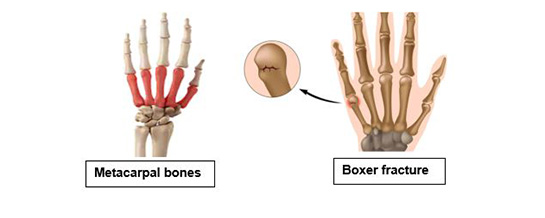How to Care for Your Child with Metacarpal Fracture
This leaflet will provide you with information about the metacarpal bone fracture, symptoms, diagnosis, treatment and home care advice.

What is Metacarpal bone fracture?
Metacarpal bones connect the wrist bones to the fingers. One or more of these bones can break or crack from a direct blow to the hand, during sports or a fall, or when the hand punches a hard surface
A boxer's fracture is a break or cracks at the end of the metacarpal bone of the little finger. It happens when someone punches a too hard surface using the wrong side of the fist.
What are the symptoms of Metacarpal bone fracture?
Symptoms of a metacarpal bone fracture include:
- Pain
- Swelling
- Bruising
- Stiffness
- A finger fracture can also make the finger bent in an abnormal position.
How is Metacarpal bone fracture diagnosed?
The doctor will ask a few questions about your child's health, examine your child, and then request an X-ray.
How is Metacarpal bone fracture treated?
- Health care providers often treat metacarpal fractures with a cast/splint.
- The cast/splint is usually removed after 3–6 weeks. Some fractures that do not heal well on their own may need surgery to bring the broken pieces of bone together, but this is not common.
- If your doctor advises giving medicine for pain, you can give:
- Paracetamol (any brand) Or, Ibuprofen (any brand)
- Follow the instruction on the medicine package for the correct dose for your child
- Do not give your child Aspirin as this can cause a serious complication
Home care advice
To help reduce the swelling and relieve pain:
- Raise the hand on pillows when your child is sitting down or sleeping.
- If your child was given a sling, use it as directed. Do not use the sling during sleep.
- Remind your child to wiggle the uninjured fingers to keep blood circulating normally
- When your child is awake, put ice in a plastic bag wrapped in a towel on the broken finger for 20 minutes every 3 hours for up to 2 days. Do not put ice directly on the skin.
Daily care if your child has a cast or splint:
- Do not remove or change the position of the cast/ splint.
- Check the area around the cast/splint. Ensure the skin is not scratched and the fingers are not pale, blue, numb or tingling.
- Make sure your child does not pick or scratch under the cast/splint.
- Do not put anything in the cast/splint. For example, make sure your child does not put toys, food or other objects into it.
- Keep dirt, sand, lotion and powder away from the cast/splint.
- Keep the cast/splint dry:
- Put a plastic covering over the cast/splint when your child bathes.
- If the cast/splint is accidentally splashed, gently blow air onto it from a hairdryer on the cool setting.
When should I seek medical advice?
Seek medical care if:
- Pain does not improve with medicine.
- Blisters, rashes or raw spots appear on the skin around the splint or cast
- A foul smell or drainage comes from the splint or cast
- Your child gets a fever
- The cast/splint feels too tight, or your child's fingers are pale, cold, numb or tingly.
- If the cast/splint cracks, becomes loose, gets wet or falls

